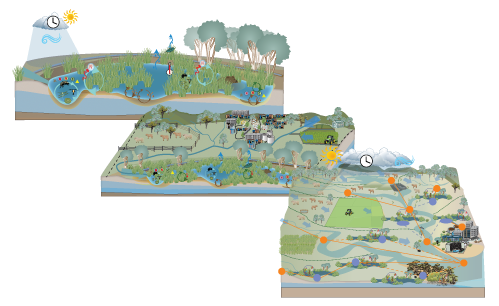|
|
Wetland hydrological modelsWetland models enable users to quantify and predict the performance of wetland systems. This is important to understand how best to use both natural and constructed treatment wetlands to improve water quality, and to support wetland rehabilitation[2].
Quick fact
Wetland hydrological modelsSelect from the tabs below
Why is modelling important for wetlands?Wetland hydrological models provide relationships among the numerous wetland forcing factors (factors exerting external influence on the wetland e.g. climatic inputs, inflow into the wetland etc.). They also incorporate relationships with wetland variables (processes occurring within the wetland e.g., relationships between climatic variables, water quality and quantity, chemical and biological processing within the wetland, etc.). Wetland models are used for many purposes, including informing policy, planning and decision making about wetland implementation and optimising functionality and performance[2]. Dynamic hydrological models differ from pictorial conceptual models and other types of models. ScaleScale is a very important consideration in terms of temporal, spatial and geographic variations in the inputs and outputs of a model. Current wetland hydrological models tend to focus on modelling individual wetlands. Scaling up the models to incorporate a catchment and to include multiple wetlands is challenging in terms of model design and function. Potential modelling issuesThe capability and accuracy of a wetland model to represent hydrological and biogeochemical processes depends on the scientific representation of the relationships between variables, and the data available as forcing data input, or to calibrate and validate the model. A model may not perform well if the relationships are not well understood or defined (or the logic of the model does not adequately represent the processes being investigated), or the available data (e.g., data obtained from a field or experimental study) is poor or limited. When this is the case, it is important to understand the uncertainty in the model output, and what steps need to be taken to reduce model uncertainty. One method to quantify uncertainty involves adjusting model parameters using upper and lower bounds of values from the literature or theory, to provide a band of model output that is highly likely to encompass the future observations[2]. LinksQWMN Wetland Hydrology Models Review Wetland Management Tools and Guides Information sources for aquatic ecosystem rehabilitation planning Water quality, water quantity and aquatic ecosystem monitoring Pages under this sectionReferences
Last updated: 31 May 2023 This page should be cited as: Department of Environment, Science and Innovation, Queensland (2023) Wetland hydrological models, WetlandInfo website, accessed 30 August 2024. Available at: https://wetlandinfo.des.qld.gov.au/wetlands/facts-maps/modelling/wetlands-modelling/ |

 — Department of Environment, Science and Innovation
— Department of Environment, Science and Innovation


